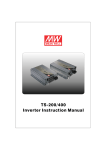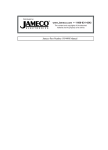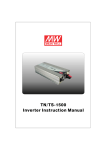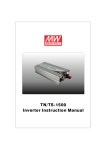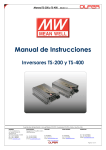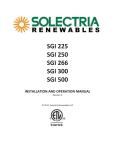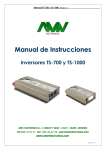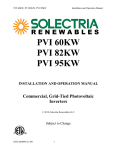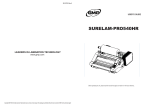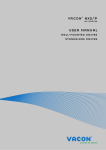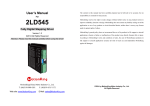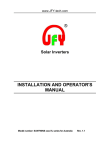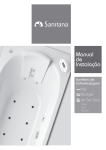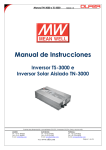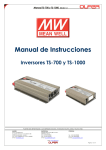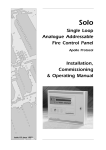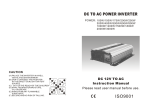Download TN/TS-3000 Inverter Instruction Manual
Transcript
TN/TS-3000
Inverter Instruction Manual
TN/TS-3000 Inverter Instruction Manual
Index
1. Safety Guidelines ...............................................................................
2. Introduction ........................................................................................
2.1 Features ........................................................................................
2.2 Main Specification ........................................................................
1
2.3 System Block Diagram ..................................................................
3. User Interface Panel ............................................................................
3.1 Front Panel ....................................................................................
3.2 AC Terminal Configuration ...........................................................
3
1
2
3
3
3
5
3.3 LED Indicator on Front Panel ...................................................... 5
3.4 Functional Indication and Alarm ................................................ 5
3.5 Rear Panel .................................................................................... 6
4. Explanation of Operating Logic ........................................................ 6
4.1 Explanation of UPS Mode Control Logic .................................... 7
4.2 Explanation of Energy Saving Mode Control Logic ................... 9
5.TN/TS-3000 Initial Output Voltage & Frequency and Procedure to
Setting Operating Mode ................................................................... 10
5.1 Initial Factory State ..................................................................... 10
5.2 Initial Setting for Transition Voltages ........................................ 11
5.3 Procedures to Setting Operating Mode, Output Voltage,
Frequency, and Standby Saving Mode ....................................... 11
5.4 Remote Monitoring Software (Optional Accessory) .................. 13
5.5 Remote Control Module (Optional Accessory) ........................... 13
6. Protection ........................................................................................... 13
6.1 Input Protection ........................................................................... 13
6.2 Output Protection ........................................................................ 14
7. Installation & Wiring .......................................................................... 15
8. Failure Correction Notes ................................................................... 17
9. Warranty ............................................................................................. 18
Dec. 2010 Version 2
1.Safety Guidelines (Please read through this manual before assembling the
inverter)
Risk of electrical shock and energy hazard. All failures should be examined by a
qualified technician. Please do not remove the case of the inverter by yourself!
After connecting the AC input of the inverter to the utility, the AC outlet of the inverter
will have AC output even if the power switch on the front panel is in the OFF position.
It is highly recommended to mount the unit horizontally.
Please do not install the inverter in places with high moisture or near water.
Please do not install the inverter in places with high ambient temperature, under
direct sunlight, or near fire source.
Please only connect batteries with the same brand and model number in one battery
bank. Using batteries from different manufacturers or different capacities is strictly
prohibited!
Never allow a spark or flame in the vicinity of the batteries.
Make sure the air flow from the fan is not obstructed at both sides (front and back)
of the inverter. (Please allow at least 15cm of space)
Please do not stack any object on the inverter as it may impede heat dissipation.
WARNING: Batteries will have aging problem after years of operation.
It is suggested to execute regular battery maintenance
(e.g. every year). Once aged, the batteries should be changed
by professional technician, or the failed batteries may cause
fire or other hazards.
Inverter
Inverter
Don't
disassemble
Keep away from
moisture
Inverter
Keep away from
fire or high
temperature
Don't stack on
the inverter
Inverter
Keep good
ventilation
2.Introduction
The TN/TS-3000 is a true sine wave DC/AC inverter fully digital controlled by an
advanced microprocessor. By using the setting button on the front panel or the
monitoring software, the user can flexibly adjust output voltage, frequency, turn
ON or OFF standby saving mode, and operating mode.
TN-3000 possesses 2 operating modes, UPS and Energy saving mode. Depending
on operating requirement, the user can flexibly reconfigure operating mode to
suit their needs. When the UPS mode is selected, AC utility voltage will automatically
be bypassed to the output load/equipment. If there is an interruption to the AC
utility voltage, battery
inverter will automatically take over power provision like
an UPS system. When the energy saving mode is selected in combination with the
use of solar panel, solar power will take priority, thus effectively saving electrical
power. Basically, the operating modes can be easily set to match weather conditions
or other special needs.
1
TN-3000 is equipped with 2 methods of battery charging. An AC charger and solar
charger coexist in this unit. The user only needs to connect their own battery banks
and solar panel to form an energy saving independent power station which is in
line with our goals of conserving energy and being environmental friendly.
TS-3000 Series only possess the inverter function. It uses batteries as the input
source and coverts it into AC power.
TN/TS-3000 Series can provide 3000W pure sine wave output continuously, 3450W
for 3 minutes, and peak power of 6000W for all kinds of loads such as inductive,
capacitive, and peak demanding motors. General applications includes PC, ITE,
yachts, RV, home appliances, motor, power tools, industrial control equipment,
AV system, and etc.
(Note: Descriptions which are highlighted represents functions exclusive
to the TN-3000 Series)
2.1 Features
True sine wave output (THD < 3.0% )
3000W rated output
Surge power capability up to 6000W
High efficiency up to 92%
Output voltage/frequency selectable
Complete protections for both the input and output
Battery low alarm and indicator
Complete LED indication for operating status
Fully digital controlled with digital display
Can be used for most electronic products requiring AC input
Selectable UPS or Energy saving mode
Utility inverter transfer time < 10ms (Typ.)
Solar charging current 30A max.
Optional remote monitoring accessory pack (includes cable + CD)
Optional remote control accessory (IRC Series)
3 year global warranty
2
2.2 Main Specifications
TN/TS-3000
MODEL
Rated
power
O Factory
U setting
T
Output voltage
P
U Frequency
T WAVEFORM
112
124
148
212
224
248
3000W continuously, 3450W for 3 minutes, 4500W for 10 seconds, 6000W
for 30 AC cycles
110V 60Hz
230V 50Hz
100 / 110 / 115 / 120V (adjustable)
200 / 220 / 230 / 240V (adjustable)
50 / 60Hz 0.1Hz
True sine wave (THD <3.0%)
PROTECTION AC short Overload Over Temperature, and circuit breaker
BAT. VOLTAGE 10.5 ~ 15.0V 21.0 ~ 30.0V 42.0 ~ 60.0V 10.5 ~ 15.0V 21.0 ~ 30.0V 42.0 ~ 60.0V
I
N
P
U
T
DC CURRENT 300A
OFF MODE
CURRENT
DRAW
75A
92%
150A
91%
300A
89%
75A
91%
150A
90%
EFFICIENCY 88%
Under 1.0mA at power switch OFF
PROTECTION Over current, battery reverse polarity, battery low alarm, and battery low shutdown
AC CHARGER
CHARGE
14.3V
VOLTAGE
CHARGE
25A
CURRENT
SOLAR PANEL
OPEN CIRCUIT
25V max.
VOLTAGE
SHORT CIRCUIT
30A max.
CURRENT
28.5V
57V
14.3V
28.5V
57V
12A
6A
25A
12A
6A
45V max.
75V max.
25V max.
45V max.
75V max.
2.3 System Block Diagram
TN-3000 Inverter
EMI
filter
AC
Input
CPU
Controller
LED
Display
AC charger
Fuse
Circuit
Breaker
Solar charger
200V DC /400V DC
Battery
12V/24V/48V
Fuse
Polarity
detect
DC/DC
Converter
DC/AC
Inverter
110V/230V
50Hz/60Hz
LOAD
AC
Output
Solar Panel
Figure 2.1 System block diagram
3.User Interface Panel
3.1 Front Panel
A POWER ON/OFF switch: The inverter will turn OFF if the switch is in the OFF
position.
B AC OUTPUT outlet: To satisfy demands of different geographic areas all over
the world, there are many optional AC outlets to choose from. (A & B types are
standard; C, D, E, F types are optional)
3
Receptacle
type
TYPE-A
TYPE-B
TYPE-C
TYPE-D
TYPE-E
TYPE-F
USA
EUROPE
AUSTRALIA
U.K
JAPAN
GFCI
Country
E13
Certificate
E13
E13
(Expect for 48V input)
I I
C No fuse breaker with reset button (for AC input): Under "bypass mode", when
the AC output is shorted or the load current exceeds the rated current of the No
Fuse Breaker, the Breaker will open and that stops bypassing energy for the
utility thus prevent possible danger. When the abnormal condition is cleared,
the user can press down on the reset button to resume operation.
D No fuse breaker with reset button (for receptacle): The AC output outlet has
a current rating of 15A. When the load current exceeds 15A, the Breaker will
open and that stops AC provision from the outlet. For application requiring more
than 15A, please use the internal terminal block behind the front panel (refer to
section 3.2).
E LED indication panel: Operating status, load condition, battery low, and all
types of warning will be displayed.
F Function setting: Operating mode, output voltage, frequency, and standby
saving mode can be set through this button.
G Communication port: For remote monitoring purpose, the unit can be connected
to a PC through this communication port by using the optional cable and monitoring
software. Also for remote control purpose, the unit can be connected to the IRC
module through this port.
H Ventilation slits: The inverter requires good ventilation for proper operation
and prolonging its lifetime.
I Frame ground (FG).
J Grommet hole for input AC utility connection.
K Grommet hole for output AC connection.
B
D
E
AC Receptacle
SOLAR CHARGE
ON
A
AC CHARGE
OFF
BATTERY
r
Ci
t
t o
R
e
Bat Low
AC IN
BY PASS
Saving
Cat.No.(1GG1HS-212)
Wire Range(10-4 AWG Str
Cu Soldered Wires)
Torque (17.7-26.5 in lb)
G
Remote
port
I I
Chassis
Ground
s
(For Receptacle)
(For AC Output)
F
0
t
s
e
0
se
Ci
se
R
Setting
On
er
t o
LOAD
100
ak
s
INVERTER
i t Br e
e
e
s
cu
Pr
er
Pr
C
i t Br e
ak
r
100
cu
I
AC INTPUT
AC OUTPUT
J
K
H
Figure 3.1 Front panel (TN-3000)
4
3.2 AC Terminal Configuration
When the load current is >15A, you must use this output terminal connection
(terminal can withstand 3000W). To ensure user safety, please follow the wiring
instructions as below:
This AC terminal block can be found inside the inverter. To access it, the front
panel must first be removed then the output wires can be screwed onto the AC
output terminal block. Insert the cable through the AC output grommet, tighten
the grommet, and then connect the other end of the cable to the load to complete
this connection.
A Terminals for AC utility input.
B Terminals for AC output connection.
C Terminal for FG connection.
AC INPUT
AC OUTPUT
L
FG
N
{
N
{
L
A
B
C
3.3 LED Indicator On Front Panel
Battery capacity indicator: represents the remaining capacity of external batteries.
LED Display
Battery
Capacity
LED 1 ON
LED 1~ 2 ON
LED 1 ~ 3 ON
LED 1 ~ 4 ON
0 ~ 25%
26 ~ 50%
51 ~ 75%
76 ~ 100%
Load condition indicator represents the magnitude of output loads.
LED Display
LED 1 ON
LED 1~ 2 ON LED 1 ~ 3 ON LED 1 ~ 4 ON
Battery
0 ~ 30%
30 ~ 50%
50 ~ 75%
75 ~ 100%
Capacity
3.4 Function Indication and Alarm
ON indicator: The inverter had started up and the output is normal.
Bat low indicator: Voltage of external batteries is too low. The inverter will
send out a "Beep" sound to warn the users.
Saving mode indicator: The inverter is operating under the "standby saving
mode" and there is no AC output.
AC CHARGE indicator: The built-in AC charger is charging the external
batteries.
SOLAR CHARGE indicator: The external solar panels are providing charging
current to the external batteries through the built-in solar charger.
AC IN indicator: The status of utility is normal.
BY PASS indicator: The unit is working under "bypass mode." The AC power
consumed by the loads is provided by the utility instead of the inverter.
INVERTER indicator: The unit is working under "inverter mode." The AC
power consumed by the loads is converted from the batteries.
5
BATTERY indicator: Display the remaining capacity of external batteries.
LOAD indicator: Display the output load level.
3.5 Rear Panel
A Battery input (+),(-).
B Solar panel input connector.
C Fan ventilation openings.
B
Reverse Polarity
Will Damage The
Unit.
NEG
POS
C
A
C
Figure 3.2 Rear panel (TN-3000)
4.Explanation of Operating Logic
TN-3000 is CPU digital controlled true sine wave DC/AC inverter. It is designed to
achieve the target of energy conservation and possesses both UPS and energy
saving modes. These 2 modes are user adjustable. The unit will be factory set in the
UPS mode. Depending on weather and utility conditions, users can manually adjust
(refer to section 5.3) or use the monitoring software to switch to the energy saving
mode.
The main difference between the UPS and Energy saving mode is the amount of
energy conserved. Under the UPS mode, the unit will remain in the bypass mode as
long as utility is available, thus less energy is conserved (refer to figure 4.1 for details
of UPS mode control logic). Under the Energy saving mode, the priority of input
source chosen is solar panel
AC utility
b a t t e r y. I f a v a i l a b l e , t h e C P U w i l l
automatically select external solar panel as its first priority in order to conserve energy.
In case of insufficient solar power and utility failure, battery power will be drawn as
the last the last resort. When the capacity of batteries drops to around 10~20%, the
CPU will remind the end user by continuously sending out warning siren until the
system shuts down.
6
4.1 Explanation of UPS Mode Control Logic
ON
ON
Utility
Power
OFF
OFF
Power-On
Re-power-on
ON
ON
By pass
mode
OFF
OFF
ON
Inverter
Mode
OFF
28.5V
t
ON
ON
OFF
OFF
t
28.5V
28.5V
28.5V
25.4V
26.5V
26.5V
22.5V
(Alarm)
26.5V
Battery
voltage
21V(Shut-down)
t
29.0V
Solar charger
state
AC charger
state
ON
ON
ON
OFF
ON
ON
t2
OFF
OFF
t3
OFF
t
ON
OFF
t1
ON
OFF
OFF
t4
t5
t6 t7
t8 t9 t10 t11
t
t12
t13
Figure 4.1 Diagram of UPS mode control logic
t1: To ensure the battery is at full capacity, when the TN-3000 is turned ON, the CPU
will execute the "bypass mode" automatically connecting the AC main to the load.
In the meantime, it will activate both the AC charger and solar charger to
simultaneously charge the batteries.
t2 : When the batteries are full (battery voltage around 28.5V), both the AC and solar
charger will be turned OFF by the CPU to prevent overcharging and reducing
battery lifetime.
t3 : At this time period, TN-3000 is still in the bypass mode. The battery voltage level
will decrease gradually due to standby power dissipation. When the batteries are
consumed to around 90% of their capacity (battery voltage around 26.5V) the
CPU will restart the charger. The CPU will use solar charging current of 3A as a
guideline. When the provided charging current is >3A (solar charge LED indicator
turns ON), the solar charger will be used to charge the battery. When the provided
solar charging current is under 3A, the AC charger will be turned ON (e.g. night
7
time or cloudy day) taking over battery charging duty and at this time the solar
charger indicator will turn OFF.
t4 : With the charger activated, voltage of the battery bank will increase gradually
until 28.5V is reached then the CPU will shut off the charger to prevent over
charging. At this time, output load is still supplied by utility.
t5 : If utility were to fail at this moment, the CPU will automatically switch (<10ms)
to the inverter mode insuring uninterrupted power.
t6 : Once utility recovers, the CPU will switch back to the bypass mode.
t7 : When battery voltage drops to below 26.5V, the CPU will again activate the
charger to charge the battery banks (refer to t3 for detailed description).
t8 : Same as t4.
t9 : Due to lack of utility, the CPU will switch to the inverter mode. Since utility is
unavailable and it is night time/cloudy, the charging function is in the OFF mode.
The AC output relies purely on battery power. So, the battery bank will be depleted
rather quickly.
t10 : As the battery discharges below 26.5V and utility remains unavailable and only
the solar charger is ON. The battery bank will continue to discharge at a quick
pace.
t11 : The battery eventually becomes completely discharged and the inverter shuts
down because utility is unavailable. Only when the solar charger current is >3A
(day time/sunny) will charging recommence and the battery voltage level will
gradually increase.
t12 : Once the battery voltage level has risen to a level capable of restarting the
inverter, the inverter will automatically restart. At this time, utility is still OFF,
so power to the load is provided by the inverter.
t13 : Utility power is still OFF. If the equipment draws power which is lower than
what the solar panel can provide and the solar current is <3A, battery charging
will terminate. Inverter will continue to provide power through the battery. The
subsequent supply period is subject to capacity of battery and load condition.
Note:
The advantage of the UPS mode is that battery voltage level will be maintained
at 90% at all times. This insures that uninterrupted power can be provided to
equipment in case of utility failure. Backup period will depend on capacity of
battery banks. UPS mode is suitable for areas where AC utility is readily available
such as offices and homes.
8
4.2 Explanation of Energy Saving Mode Control Logic
ON
Utility
Power
OFF
Power-On
ON
ON
Bypass
mode
OFF
OFF
ON
Inverter
Mode
ON
OFF
OFF
OFF
28.5V
26.5V
Battery
voltage
Solar charger
state
AC charger
state
26.5V
22.5V
(Alarm)
22.5V
(Alarm)
26.5V
22V
ON
ON
21.0V (Shut-down)
ON
OFF
t
ON
ON
OFF
OFF
t1
t
ON
OFF
OFF
OFF
t
28.5V
28.5V
28.5V
t
ON
t2
t3
t4
t5
t6 t7
t
t8
Figure 4.2 Diagram of energy saving mode control logic
t1 : To ensure the battery is at full capacity, when the TN-3000 is turned ON, the CPU
will execute the "bypass mode" automatically connecting the AC main to the
load. In the meantime, it will activate both the AC charger and solar charger to
simultaneously charge the batteries.
t2 : When the batteries are full (battery voltage around 28.5V), both the AC and solar
charger will be turned OFF by the CPU to prevent overcharging and reducing
battery lifetime. The CPU will also switch to inverter mode and the AC electricity
provided to the loads will be coming from the batteries.
t3 : When the batteries are depleted to around 90% of their capacity (battery voltage
around 26.5V), CPU will start up the solar charger but not the AC charger to achieve
the goal of energy saving.
t4 : If the energy provided by the solar panels is larger than the load requirement,
voltage of the battery bank will increase gradually until reaching battery voltage
around 28.5V and then the solar charger will shut off to prevent the batteries
from overcharging.
9
t5 : When the capacity of batteries goes down to battery voltage around 26.5V, solar
charger will restart and begin charging.
t6 : If the energy provided by the solar panels is lower than consumed by the loads,
voltage of the battery bank will decrease gradually to battery voltage around
22.5V. The built-in buzzer will sound to inform the user that battery power is
very low.
t7 : If the power consumption of the loads does not decrease and the AC main is
normal, the CPU will detect this and the unit will be transferred to "bypass mode."
The utility will provide electricity to the loads and charge the battery bank at the
same time in order to prevent the unit from shutting off. If the solar current is
higher than 3A, the CPU will not activate the AC charger and just let the solar
changer charge the batteries to achieve energy saving target.
t8 : When there is no AC main, the CPU will shutdown the whole system if the external
battery bank voltage is less than 21V in order to prevent over-discharging and
reducing its lifetime. After shutdown, the CPU will still provide LED indication
so the user knows why the inverter has shut off.
Note:
The advantage of the energy saving mode is that the user only has to add solar
panels and solar energy can be harnessed and stored in battery bank for
conversion to AC voltage. The user no longer has to rely on AC mains for
electricity. The sun can provide all the free electricity needed. Energy saving
mode is suitable for areas where AC utility is not readily available such as
mountain tops, boats, and vehicles. Even when AC utility is available, the main
source of power will still be solar, AC utility will supplement only when necessary.
This type of design cuts back the use of paid electricity thus reaching the goal
of energy conservation.
5.TN/TS-3000 Initial Output Voltage & Frequency and Procedure to Setting
Operating Mode
5.1 Initial Factory State
Initial factory setting is 110V / 60Hz or 230V / 50Hz and both "UPS mode" and
"standby saving mode" are activated. If the users need to revise it for their
application, it can be done through the setting button on the front panel to update
the CPU setting (please refer to section 5.3 for setting procedures). The unit
will start up automatically after the setting procedure is completed and the new
settings will be executed. These new settings will be kept even if AC utility, battery,
and solar is disconnected. Occurrence of fault conditions leading to inverter
shutdown and requiring repower ON will also not affect the new settings.
10
5.2 Initial Setting for Transition Voltages
TN/TS-3000
Factory Setting
112
212
124
224
AC charger
14.3V
28.5V
transition voltage
AC charger
11V
22V
start up voltage
Solar charger
13.3V
26.5V
start up voltage
Solar charger
14.3V
28.5V
shutdown voltage
Inverter
10.5V
21V
shutdown
148
248
57V
44V
53V
57V
42V
5.3 Procedures to Setting Operating Mode, Output Voltage, Frequency, and
Standby Saving Mode
AC Receptacle
SOLAR CHARGE
ON
AC CHARGE
OFF
R
r
LOAD
100
Setting
Ci
On
t
0
s
t o
R
e
Bat Low
AC IN
BY PASS
Saving
(For Receptacle)
(For AC Output)
Chassis
Ground
0
se
Ci
t o
e
e
se
t
Pr
Pr
s
s
e
BATTERY
INVERTER
i t Br e
er
er
s
cu
ak
i t Br e
ak
r
100
cu
Cat.No.(1GG1HS-212)
Wire Range(10-4 AWG Str
Cu Soldered Wires)
Torque (17.7-26.5 in lb)
Use an insulated stick to
press this setting button
Remote
port
AC INTPUT
AC OUTPUT
Figure 5.1: Adjustment of output mode, output voltage,
frequency, and saving mode
Note
TS-3000 does not have steps 3~4.
Procedure 1 involves "UPS mode" and "Energy Saving mode" selection, the
steps are as follows:
Step 1
Step 2
S te p 3
The inverter should be turned off while resetting. Input batteries should
be connected, AC main can either be connected or disconnected, and
the loads should be removed.
Use an insulated stick to press down on the setting button and then turn
on the power switch. After pressing for 5 seconds, the inverter will send
out a "Beep" sound. User can release the button and go on with the setting
procedure.
P l e a s e r e fe r to Ta b l e 5 .1 a n d c h e c k th e L E D i n d i c a ti o n to s e e i f th e
operating mode is the one you need. If Yes, hold down on the setting
button for 3~5 seconds and the inverter will let out a beep sound signaling
that you had skipped to procedure 2 (voltage & frequency setting).
However, if change is required please go on to step 4.
11
(Factory setting: UPS mode)
Energy saving
mode
On
Bat Low
Light
Dark
Flashing
Saving
On
UPS mode
Bat Low
Saving
Table 5.1 LED indication for operating mode
Step 4 The LEDs will change state from pressing the setting button for 1 second
and then release. Operating mode can be adjusted as required. After
selecting the operating mode, press the setting button for 3~5 seconds
and the inverter will let out a beep sound. Released the button and you
will go on to procedure 2 (voltage & frequency setting).
Procedure 2 involves voltage and frequency selection, the steps are as follows:
Step 1 Please refer to Table 5.2 and check whether the combination of output
voltage and frequency is what you need. If Yes, hold down on the setting
button for 3~5 seconds and the inverter will let out a beep sound signaling
that you had skipped to procedure 3 (saving mode). However, if change
is required please go on to step 2.
(Factory setting: 230VAC/50Hz or 110VAC/60Hz)
Output
Voltage
Frequency
100Vac
(200Vac)
110Vac
(220Vac)
115Vac
(230Vac)
120Vac
(240Vac)
On
50Hz Bat Low
Saving
On
60Hz Bat Low
Saving
Light
Dark
Flashing
Table 5.2 LED Indication for voltage/frequency combinations
Step 2 The LEDs will change state from pressing the setting button for 1 second
and then release. Please select the combination of output voltage and
frequency you need. After making your selection, press the setting button
for 3~5 seconds and the inverter will let out a beep sound. Released the
button and you will go on to procedure 3 (saving mode).
110V
(220V) 50Hz
115V
(230V)50Hz
120V
(240V) 50Hz
100V
(200V) 50Hz
100V
(200V) 60Hz
120V
(240V) 60Hz
115V
(230V)60Hz
110V
(220V) 60Hz
Figure 5.2 Circulation diagrams of output voltage and frequency
12
Procedure 3 involves standby saving mode selection, the steps are as follows:
Step 1 Please refer to Table 5.3 and check whether the "saving mode" is set as
required. If yes, hold down on the setting button for 5 seconds and the
inverter will let out a beep sound. Released the button and the inverter
will automatically store all settings and then restart. However, if change
is required please go on to step 2.
(Factory setting: Enable saving mode)
On
Saving mode
ON
Saving mode
OFF
Bat Low
Light
Dark
Flashing
Saving
On
Bat Low
Saving
Table 5.3 LED indication for saving mode ON/OFF
Step 2
The LEDs will change state from pressing the setting button for 1 second
and then release. "Saving mode" can be activated or cancelled according
to your need.
5.4 Remote Monitoring Software (Optional Accessory)
Users can make operating mode, voltage / frequency, saving mode, and transition
voltage adjustments by using this software. Software update can be downloaded
from the MW website. Please contact us or our distributor if you have any questions.
5.5 Remote Control Module (Optional Accessory)
(A) User can purchase and use the remote control module to control inverter
ON/OFF, turn saving mode ON/OFF, and observe inverter status.
(B)Compatible models:
IRC1 : TS-700 / 1000 / 1500 / 3000 TN-1500 / 3000
IRC2 : TS-700 / 1000 / 1500 / 3000
IRC3 : TN-1500 / 3000
(C)Comes with 10FT connection cable (standard) and 25FT/50FT are optional.
6.Protection
6.1 Input Protection
(A)Battery polarity protection: If the battery input is connected in reverse
polarity, the internal fuse will blow and the inverter should be send back to us
or our authorized distributor for repair.
(B)Battery under voltage protection: When the battery voltage is lower than
the pre-set value, the inverter will automatically terminate the output and the
"battery low" signal on the display panel will light up. Please refer to table 6.1
for more details about failure signals displayed on the panel.
(C)Battery over voltage protection: When the battery voltage is too high,
inverter will automatically terminate the output and the built-in buzzer will
13
sound to inform the user. Please refer to table 6.1 for more details about failure
signals displayed on the panel.
WARNING:
Please choose suitable batteries that is within the input DC voltage range
of the inverter (refer to spec).
If the input DC voltage is too low (ex. using 12Vdc battery bank for 24Vdc
models), the inverter cannot startup properly.
If the input DC voltage is too high (ex. using 48Vdc battery bank for 24Vdc
models), the inverter will get damaged.
(D)Solar charger over current protection: TN-3000 can provide max solar
charging current of 30A. If the charging current is too high, the internal fuse
will blow and the inverter should be send back to MW for repair.
6.2 Output Protection
(A)Bypass mode: Use no fuse circuit breaker as automatic over current protection.
When over current occurs, the reset button of the circuit breaker on the front
panel will pop up and the inverter will shut down. At this time, users should
remove the loads, restart the inverter and press down on the reset button of
the circuit breaker and the AC output can now be provided normally.
(B)Inverter mode: Under the inverter mode, if any abnormal situation occurs,
the display panel will send out failure message (please refer to table 6.1 for
failure condition).
(1) OTP: When the internal temperature is higher than the limit value, OTP will
activate leading to automatic shutdown. It must be restarted.
(2) Abnormal AC output protection: If the AC output voltage of the inverter
is too high or low, the unit will turn OFF and should be restarted again.
(3) AC output short circuit protection: When a short circuit situation occurs
at the output or the load increase drastically in a short period of time, the
unit will turn OFF and should be restarted again.
(4) Abnormal battery voltage protection: When the battery voltage is too
high or low, this protection will be activated. The inverter auto-recovers
once the battery goes back to a safe level and the user do not have to
restart it.
(5) Output overload protection: When the output is overloaded between
3000W~3450W, the inverter can continuously provide power for 3 minutes.
After that, if the overload condition is not removed, the overload protection
will be activated. When the load is higher than 4500W, the overload protection
will activate instantly.
14
Table 6.1 Failure messages on the display panel
LOAD
Failure
message
LED
Indicator
Output
overload
(3000W~3450W)
LOAD
Output
overload
(3450W~4500W)
LOAD
Output
overload
(>4500W)
LOAD
LOAD
Failure
message
100
0
LED
Indicator
100
AC output
short circuit
0
0
Abnormal
battery
voltage
100
0
LOAD
100
0
LOAD
100
Battery
aging
0
0
LOAD
LOAD
100
100
Fan
abnormality
0
0
LOAD
LOAD
Abnormal AC
output voltage
0
LOAD
100
100
Over
temperature
100
100
Remote
shutdown
100
0
0
7. Installation & Wiring
(A)Wiring for batteries: Wire connection should be made as short as possible and
less than 1.5m is highly recommended. Also make sure suitable wires are chosen
based on safety requirement and current rating. Too small cross section will
result in lower efficiency, less output power, and the wires may also become
overheated and cause danger. Please refer to table 7.1 or consult us or our
distributor if you have any questions.
Rated current of
equipment (amp)
Cross section of wire
lead (mm 2)
AWG
Note
Choosing suitable
wires based on the
rating of solar panels
and distance from
the inverter
10A ~ 13A
1.25
16
13A ~ 16A
1.5
14
16A ~ 25A
2.5
12
25A ~ 32A
4
10
63A ~ 80A
16
4
80A ~ 100A
25
2
125A ~ 160A
50
0
160A ~ 190A
70
000
260A ~ 300A
150
300kcmil
300A ~ 340A
185
400kcmil
Table 7.1 Suggestion for wire selection
15
Models using 48V
batteries
Models using 24V
batteries
Models using 12V
batteries
(B)Suggested battery type and capacity
TN/TS-3000
Battery type
Battery
capacity
Lead-acid
112
212
12V / 400Ah
or higher
Input current
from solar panel
124
224
148
24V / 200Ah
or higher
248
48V / 100Ah
or higher
30A max.
(C)Installation requirements:
The unit should be mounted on a flat surface or holding rack with suitable strength.
In order to ensure the lifespan of the unit, please refrain from operating the unit
in high dust or moisture environment. This is a power unit with built-in DC fan.
Please make sure the ventilation openings are not blocked and refrain from
continuous operation with heavy load in high ambient environment because this
may prevent inverter from operating properly and its life span may be affected.
We highly recommend that there should be no objects impeding airflow within
15cm of the ventilation openings.
>15cm
>15cm
Inverter
Air
Air
Figure 7.1 Example of installation
(D)Example of system setup
As short as possible
AC O/P
Solar Panel
Battery
+
-
Larger
than
15cm
LOAD
TN/TS-3000
Inverter
Larger
than
15cm
AC I/P DC I/P
-+
Solar I/P
Chassis
Should be less than 1m
Depending on the actual length of wiring,
choose suitable cross-section of the leads
16
Wall or system FG
100
100
80
80
LOAD (%)
LOAD (%)
(E)Derating
60
40
20
60
40
20
0
10
20
30
40
50
60
Ambient Temperature (
70
10.5VDC
21VDC
42VDC
)
11.5VDC
23VDC
46VDC
15VDC (HORIZONTAL)
30VDC
60VDC
Battery input voltage (V)
Figure 7.2: Output derating curve
Figure 7.3 Input derating curve
(F)
Notes on output loads:
TN/TS-3000 Series can power most equipment requiring an AC source of
3000W. But for certain type of load, the unit may not work properly.
(1)Since inductive loads or motor based equipments needs a large start up current
(6~10 times of its rated current), please make sure this startup current is less
than the maximum current capability of the inverter.
(2)When the loads are capacitive or rectified equipments (such as switching
power supply), we suggest operating these equipment at no load or light load
during power ON. Increase the load slowly only after the TN/TS-3000 has
started up to ensure proper operation.
8.Failure Correction Notes
TN/TS-3000 is a complex product which should be serviced by professional technician.
Improper usage or modification may damage the unit or result in shock hazard. If you
are not able to clear the failure condition according to the following instructions,
please contact us or your closest distributor for repair service.
Failure status
Possible reasons
Recommended solutions
Abnormal input
Check the AC or DC input sources
(solar/battery) to make sure the
voltage is within the required range.
Over temperature
protection
Make sure that the ventilation is not
block and the ambient temperature is
not too high. Please derate load usage
or lower the ambient temperature.
Overload protection
Make sure the output load does not
exceed the rated value or the peak
startup current is not too high, typically
found in inductive or capacitive loads.
Short circuit protection
Make sure the output is not
overloaded or short circuited.
No AC output
voltage
17
Failure status
Possible reasons
Recommended solutions
No voltage at
the AC outlet
No fuse circuit breaker
has activated
Check whether the load exceeds
15A.
Check whether the load has
exceeded 20A(212/224/248)
or 40A(112/124/148)
No voltage at
No fuse circuit breaker
the AC terminal
has activated
block
Battery aged or broken
Replace the batteries.
Discharging
Battery capacity is too
period for battery small
is too short
Malfunction of the charger
(no charge voltage)
Fan does not
work
Reconfirm battery specification and
enlarge the battery capacity as suggested.
Please return to us for repair.
Clog with foreign object
Remove foreign object.
Fan malfunction
Please return to us for repair.
9.Warranty
Three years of warranty is provided under normal operating conditions.
Please do not change components or modify the unit by yourself or attempt
to repair the unit by yourself because Mean Well reserves the right to void the
warranty.
18





















